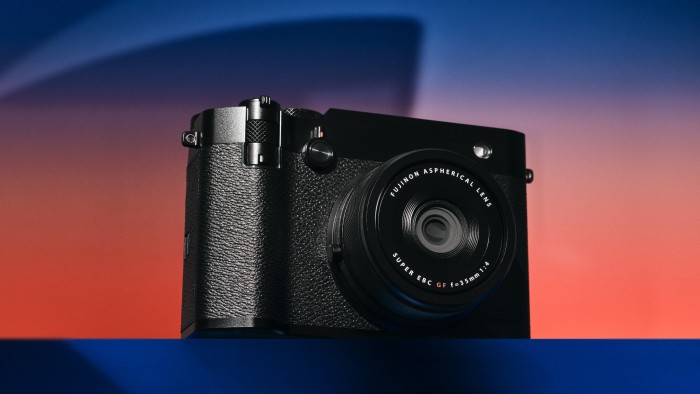Unlock the Editor’s Digest for free
Roula Khalaf, Editor of the FT, selects her favourite stories in this weekly newsletter.
Through a lens brightly
Fujifilm GFX100R
Price: £4,699
BUY
Just as vinyl has a certain quality of sound that its fans will try their best to explain, medium-format cameras produce a look that you simply can’t get from full frame, and for reasons that are less subjective and more rooted in maths. Here, Fujifilm has put a 102-megapixel sensor into the first camera of its GFX range to have a fixed lens, namely a 35mm f/4 (equivalent to 28mm f/3.2 in full-frame money). What does that mean, practically? A relatively shallow depth of field lets you isolate your subject beautifully, while landscape shots benefit from a wide angle of view with a natural perspective. All told, it’s an exceptionally powerful creative tool, and comes in a lightweight, highly toteable form (735g) that you associate more with Fujifilm’s popular X100 series.
I got hands-on with the silver version – it’s also available in black – which is exquisitely machined and has a typically retro look and feel. Shutter speed is set through the main dial, and ISO by lifting and turning it (like a film camera), so you know where you are even before you’ve turned it on. As a relative rookie, I inevitably feel safer with auto settings, but one of its great strengths is its adaptability. Pros will appreciate the level of control it affords (and the power to reassign buttons to match the ergonomics of their favourite cameras), while someone like me can bumble around more haphazardly, learning as I shoot and producing unexpectedly gorgeous results along the way.
New to this GFX model is an aspect ratio dial, letting you switch between native 4:3 and eight others, including 1:1, 16:9 and even 65:24 (evoking the panoramic feel of TX-1/XPAN), while various masking and guideline options let you see what’s going on around the frame. Beautiful film simulations include black-and-white Acros+R (a red filter ideal for landscapes), Velvia (sunrises and sunsets), Astia, Sepia and more than a dozen others.
I barely scratched the surface of its capabilities – including 4K video – during my few days with it, but found myself bonding with the camera nonetheless; keen to pick it up, keen to see how it sees the world.
The stills point

Hasselblad 907X & CFV 100C
Price: £6,729
BUY
This gorgeous medium-format stills camera guides you gently into the modular world of Hasselblad. The CFV 100C digital back can be used with its film cameras dating back to the 1950s, while the super-slim 907X body is compatible with its XCD range of lenses (and a bunch of others via an adapter). It’s designed to be used mainly at waist height, composing your shots by looking down at its bright 3.2in screen that can tilt up as far as the horizontal – or, of course, it can be mounted on a tripod. That, combined with its engineering (never before has a USB port made me sigh with delight) and sumptuous touch- screen interface, makes for a unique shooting experience, with pictures to match.
A moving experience

Leica SL3-S
Price: £4,500
BUY
Pitched at videographers as much as photographers, the latest in Leica’s SL range boasts 6K open gate, allowing you to shoot video using the full sensor and crop into your chosen aspect ratio without losing quality. Leica has also stepped up the speed of the autofocus – no fewer than 779 phase detection points – making it perfect for capturing anything moving fast. A flip-out screen lets you shoot from the hip, but I found the viewfinder’s eyecup housing equally inviting. There’s a wealth of compatible L-mount lenses, while the minimal design echoes Leica’s “das Wesentliche” (“what really matters”) ethos: unlabelled buttons and wheels that can be customised as you wish, with a neat LCD info panel reminding you what’s what.
Life of the party

Polaroid Flip
Price: £199.99
BUY
Polaroid has delved into its past and grabbed two elements in particular for this new, mid-priced instant: a flip-up and fold-away flash (the clamshell design protects all the precious parts of the camera) and an old-school, sonar-based auto-focus system that assesses the distance from the subject of the shot and then mechanically switches in the most appropriate of four internal lenses, optician style. It’s as simple to operate as you’d hope from such a camera, although connecting it to the Polaroid app (which is so easy to do – I wish all gadget apps were this seamless) gives you more extensive manual control. It’s built like a tank (like me) and great at parties (not so much).
No fuss

Sigma BF
Price: £1,969
BUY
The minimal design of this full-frame, mirrorless, interchangeable-lens camera is quirky bordering on the audacious. Carved from a single block of aluminium, it has no controls on the top aside from an electronic shutter button, no viewfinder, and just three small buttons and a rotating dial alongside its screen. But this bold shake-up of the interface is quick to master and fun to use. The current setting (ISO, white balance, aspect ratio etc) is shown in a small display above the main dial, letting you scroll and tweak while leaving the main screen free of clutter. If the idea is to emphasise the fundamentals of photography and encourage people to enjoy shooting, it succeeds without a doubt.
@rhodri
